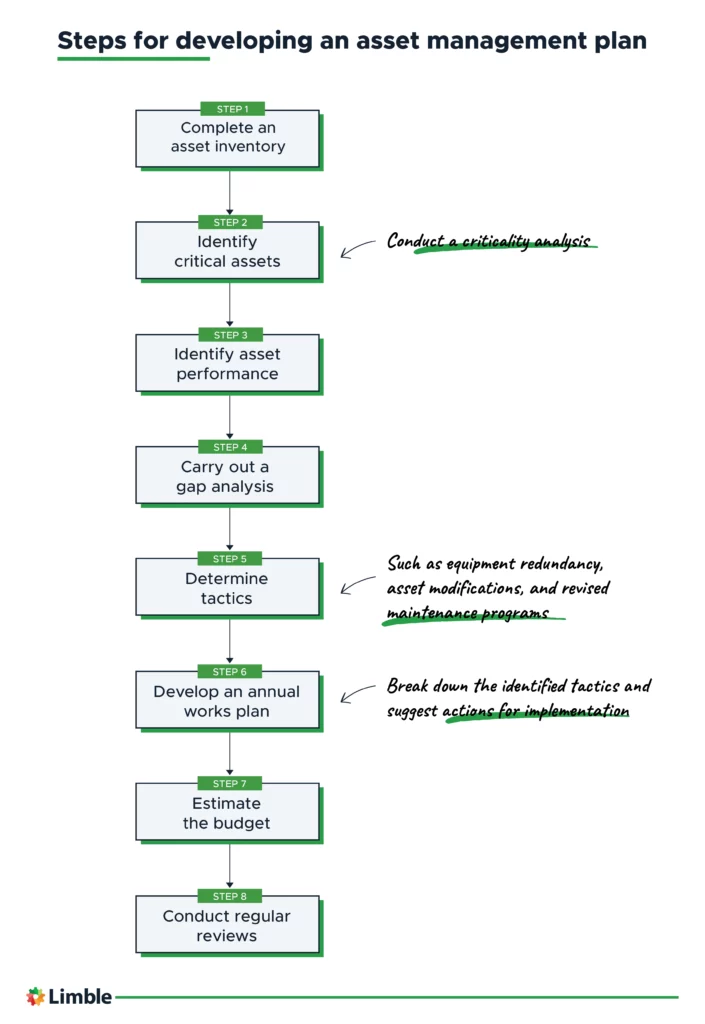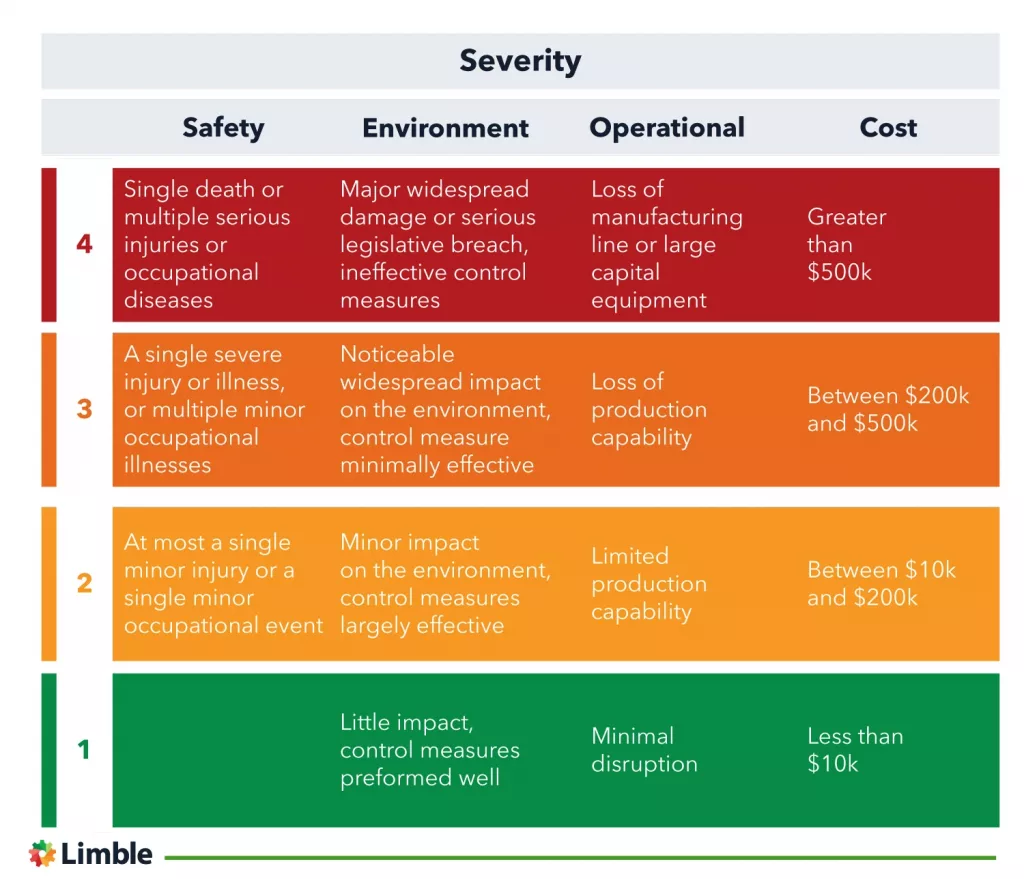 Managers often misunderstand the purpose of facility asset management plans. They are often written with the wrong scope or intent, or aren’t aligned with team or organization goals and strategies. As a result, they frequently fail to deliver their intended benefit.
Managers often misunderstand the purpose of facility asset management plans. They are often written with the wrong scope or intent, or aren’t aligned with team or organization goals and strategies. As a result, they frequently fail to deliver their intended benefit.
We’re here to ensure that doesn’t happen to you. In this article, we’ll explain what a facility asset management plan is and show you how to create one, covering helpful examples along the way.
The purpose of a facility asset management plan
A hierarchy of asset management documents begins with an asset management policy, flows into an asset management strategy, and ends with a series of asset management plans.
Each document level serves a particular purpose, which, when combined, supports a business’s asset purchase, use, care, and disposal expectations.
An asset management plan is a document detailing a department’s process to turn a defined strategy into actionable steps. Unlike policy or strategy documents, the wording and focus are short-term, measurable, and dynamic.
A company will have only one asset management strategy but may have multiple asset management plans. It’s common for each internal department to have a plan that focuses solely on the assets and particular context within the department.
 Developing an asset management plan
Developing an asset management plan
A facility asset management plan is an operationally focused document that has no room for aspirational statements. Think of it as a tactical checklist, listing tasks to achieve within a certain timeframe and budget. The goal of this document is to implement the higher-level objectives outlined in the asset management strategy document.

The following steps will help you gather the data you need to write an effective facility asset management plan.
1. Complete an asset inventory
Asset inventory requires more data than just asset location. A detailed asset inventory should contain the following information (estimate the following information where it’s available):
-
- Asset location: If you have an asset tracking system in place, you should already have this information.
- Asset condition: Don’t simply cover asset operation and maintenance in this assessment. Check whether the asset is clean and cosmetically well-maintained, is it compliant with safety requirements, is it experiencing performance issues, etc.
- Asset value: The finance department should list depreciated values for each company’s asset. Note down if this theoretical value contradicts the asset’s condition.
- Remaining life: This estimate is very subjective, but consider how long the equipment will go on performing its function before a replacement is needed. We’re not talking about economic life; we’ll cover that soon. Just quantify its mechanical life if maintained to its current standard.
Checklist for Creating a Preventive Maintenance Plan
Following a consistent Preventive Maintenance Plan can make life easier. Use this checklist to create your own!

2. Identify critical assets
The most straightforward way to identify assets is to perform a criticality analysis. You’re looking to analyze how each asset failure impacts your costs, operations, environmental complaints, and safety.
Create a scale with metrics to rank the severity. For instance, equipment failure with a low severity may rank at 1 and cost the business less than $10,000, but a high severity of 5 may be over $500,000 or even potentially close the business.

This criticality ranking helps you rank the assets and identify those that deserve more attention from your maintenance team.
3. Identify asset performance
The goal is to understand how well each asset performs its role in making the company profitable, compliant, and safe.
Keep in mind that even newer assets in good operating condition can perform below the expected standards or require very high maintenance expenditures to function optimally.
The easiest way to gauge asset performance is to consult your computerized maintenance management software (CMMS). Check the asset’s maintenance costs, as well as its reliability and performance metrics.
Compare these in-service results with industry norms to understand how well your assets are performing.
4. Carry out a gap analysis against strategy expectations
Steps one through three will provide insight into your asset performance, useful life, criticality, and costs. With this foundation, you can compare the current asset state and capability against the objectives of the asset management strategy.
Suppose the asset management strategy states that asset lifecycle costs must get reduced by 25%, production efficiency should improve by 30%, or the non-conforming product metric must reduce from 9% to 3%.
By understanding the current conditions on your plant floor, you will immediately see if you can reach those goals. If not, you should also be able to identify problematic assets and processes you need to improve to get where you need to go.
5. Determine tactics to close the gap between performance and expectation
Once you know where you’re falling short, you can develop a list of tactics to help fix these issues.
These tactics will often be wide-ranging and may include:
- Improving operator performance
- Implementing more equipment redundancy
- Investing in asset modifications
- Revising existing or implementing new maintenance programs
- Changing maintenance contractors and vendors.
6. Develop an annual works plan
Now it’s time to break down the tactics you identified in the previous step and outline a plan for their implementation. Think of this as a project plan with costs and justifications.
Look three to five years ahead and consider the following (don’t forget to define the starting and completion dates):
- Prioritize quick wins: You identified glaring deficiencies or easy fixes during your analysis. Focus on the easy ones first to start generating rapid results and increase worker and management support.
- Identify maintenance modifications: Changing a maintenance plan requires careful consideration and planning to prevent disruption. Collaborate with the engineering and maintenance teams to gain agreement on actions, dates, and resource requirements.
- Allocate the needed resources: Training existing employees, modifying schedules, or implementing new hires all require coordination and planning. Don’t forget to communicate these changes before they happen, and involve HR in the discussion. Also, define the costs of these changes.
- Highlight changes to the asset lifecycle: Discuss, plan, and define costs of any equipment modification, disposal, and new purchases. Communicate those to your procurement team.
- Plan operational changes: List the required operational changes (shift amendments, upskilling plans, involving operators in equipment maintenance). Discuss changes with all stakeholders.
7. Estimate the budget
Estimate all changes and capture the direct costs for implementation, along with its effects on:
- Asset longevity
- Capital apportionment
- Spare-holding costs.
-
-
Remember, the cost of an asset usually forms only about 20% of the total cost of ownership, with the rest being the remainder of the lifecycle costs.
Use net present value (NPV) calculations to support major investments.
8. Conduct regular reviews
Make sure to schedule regular reviews of the asset management plan. Check if everything is on schedule and within the estimated budget, and whether the changes are leading to the desired outcomes.
A typical structure of an asset management plan document
You will never find two identical asset management plans. They vary by industry and the specific context within the department.
However, the following structure can be used as a guide when writing such a document.

1. Summary
The summary should highlight the key takeaways from the gap analysis and subsequent tactics, actions, timeframes, and expected outcomes.
As a concise overview, it should give the reader a taste of what’s to follow.
2. Purpose and scope
This chapter aligns the actions in the plan with the objectives of the overarching asset strategy.
It should place a boundary around the plan’s impact by describing the departmental or geographical limits it applies to, and the time span over which the plan will be relevant.
3. Current assessment
Explains the major roadblocks or restrictions that make strategic objectives difficult to achieve.
Group the identified issues under common headings. It could be poor critical equipment reliability, sup-optimal skill levels, or a lack of resources.
4. Future performance
This chapter links the successful corrections of the current deficiencies to positive changes supporting the objectives from your asset strategy.
Explain — in measurable terms — the benefits that will accrue to the business.
5. Maintenance program
Changes in operating philosophy, equipment modifications, new assets, or reliability initiatives will require a review and adjustments to the maintenance program.
The shift may be:
- A transition from planned maintenance to total productive maintenance (TPM)
- Revised shift pattern
- New tooling
- Improved spare holdings.
-
-
Detail what must change to accommodate or promote improved asset performance and longevity.
6. Financial calculations
If you spend a dollar in business, you must be sure you’ll get at least two back.
In this section, lay out the budget for your plan, show how that expenditure will repay itself through performance in line with strategic objectives, and set the timescale within which you expect to see a result.
7. Improvement action plan
This section is the monthly project plan that shows the start and completion date of each initiative and, preferably, those responsible and accountable for the event.
This chapter will be your roadmap with which you can build key performance indicators and reward successful implementation.
A few examples of different asset management plans
Finding examples relevant to the private industry is a challenge. Most private companies keep such plans confidential.
Still, we can find examples from public utilities, which help show the wide differences in format and style:
-
- Cheshire East Council: The UK city’s council plan dives a little more into strategy than an internal departmental action plan usually would. It has a good three-year action plan stipulating when tasks or review activities will begin and finish.
- Auckland Council: This New Zealand city’s council plan is far more comprehensive than the one expected from a department in a manufacturing company. However, it discusses the strategic aim of the council and the gap analysis against current performance. There are also extensive CAPEX and OPEX calculations, with timelines of specific initiatives.
- Thunder Bay: Canadian city’s plan has useful examples of asset condition estimation, age, estimated useful life, and service levels received from the assets. As this is a first-stage plan for asset management, rather than discreet actions for each asset, it lays out a timetable for the next stage of asset analysis and evaluation. Appendix F also shows how the plan aligns with other corporate planning departments.
Get the most out of your assets
Facility asset management plans are essential components of an organization’s asset management initiative. They are short-term tactical plans that:
- Indicate the steps a business or department will take to meet the objectives of their asset management strategy
- Justify budget spending
- Set key performance indicators (KPIs) to track.
-
-
Creating an asset plan that follows your policy and strategy documents can help you get the most out of your assets, maximize operational effectiveness, and can give you an edge over your competitors. To learn more about asset management and maintenance, keep browsing the Limble blog.
